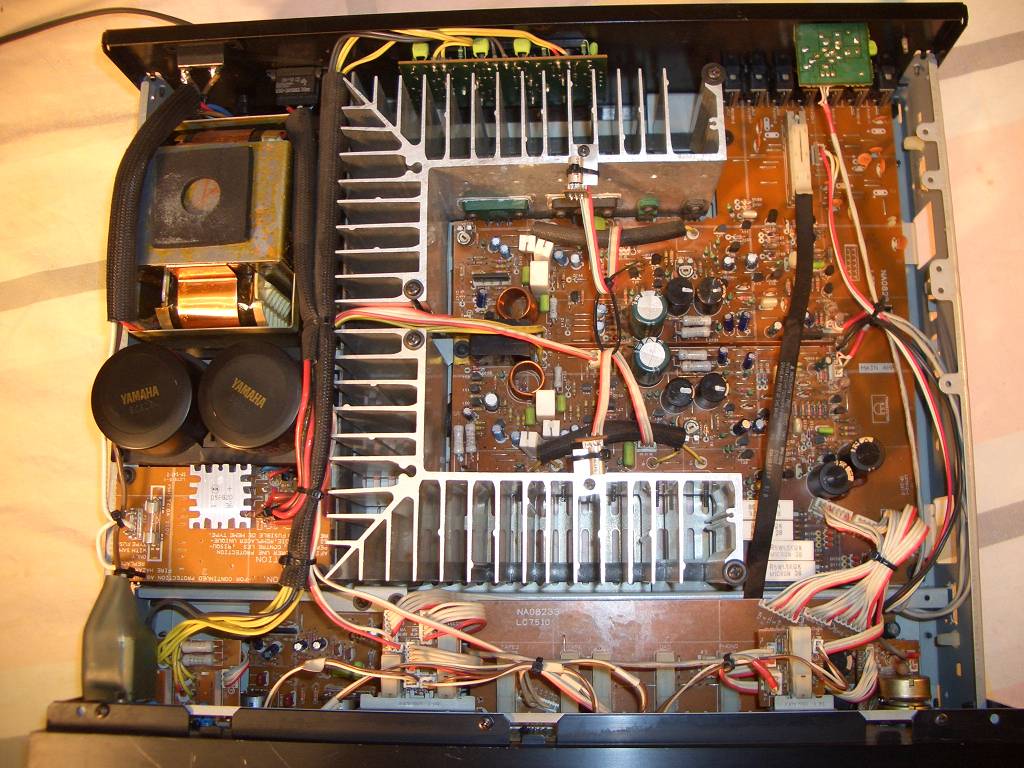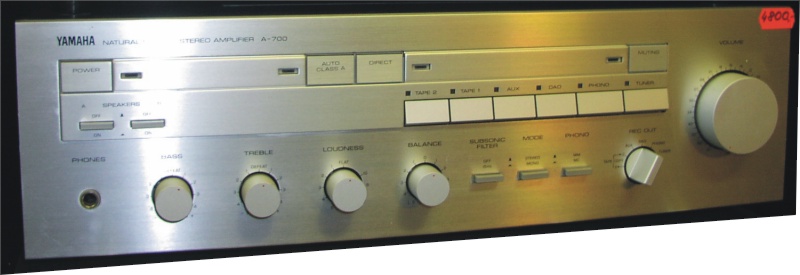
A/B Comparison #5
-
Sigma 22 power supply.
-
Three-channel "Active Ground" topology.
.
-
1983 Japanese "mid-fi" amplifier.
-
Not to be confused with 2010 Yamaha A-S700
NOTES:
- The A-700 was produced by Yamaha in the mid 1980's. Mine is black, but there was a silver model also.
- Rated 100 watts / channel RMS 20 Hz~20 kHz at 0.005% thd
- Can be switched to run in Class A up to 5 watts then runs class B. Normal changeover to ClassB is less than 1 watt. ( This is the "Auto Class A" switch)
- Headphone jack is typical practice, it has series resistors between the headphones and the amp's output stage.
- Spec sheet states: "Headphone jack 0.81 V / 270 ohms 0.05% THD
I got this in 2007 for $29 on eBay. I haven't used it much. AudioKarma has a number of posts praising this amp's sound, calling it "Yahama's best-sounding integrated" and so on. Apparently, it has a reputation for sounding pretty good. I bought it when I was looking for cheap, low-power class-A amplifiers to use to power a ribbon tweeter in a tri-amp DIY speaker.
INTERESTING: The line (AUX) input stage clipped like crazy when I fed the signal from my DACMagic into it. At the level that the Beta-22 and all the other amps were comfortable, this amp's line stage clipped like crazy. The AUX / TAPE / TUNER inputs have a rated sensitivity of 150 mV and 47k ohm impedance. This is pretty standard for integrated amps of this era; nowadays, 300 mV or so is more common. Still, I had to pad the inputs down by 12 dB with an attenuator to get a signal that wouldn't clip the line stage.
There is a "DIRECT" button on this unit that disables tone controls, subsonic filter and loudness EQ. I performed the test using this "DIRECT" setting to disable all the tone controls, etc.
LCD-2
The Yamaha A-700 showed some differences compared to the Beta-22. Bass from the Beta-22 had somewhat more solidity, greater impact. The overall mids and highs sounded clearer from the Beta-22 though not by a huge amount. Vocals and piano sounded more natural through the Beta-22 and there was a slightly fatiguing quality to the highs though the Yamaha.
HD-800
Similar to the LCD-2, the bass though the Beta-22 sounded a little more solid and punchier than the Yamaha. Upper highs sounded rolled off a tiny bit through the Yamaha and in general the mids and highs sounded more natural and cleaner through the Beta-22. Again, the highs from the Yamaha had a slightly fatiguing quality. Transient detail through the Beta 22 was better- audience claps in time with the music from Patricia Barber's Companion cd were rendered with greater clarity though the Beta-22- individual claps stood out as sounds distinct from one another and from the music and with with more realism with the Beta-22. With the Yamaha the individual audience members clapping in time to the song sort of merged into one rhythmic sound.
MY CONCLUSIONS
CONCLUSION: First of all, let me say that the headphone jack of this old Yamaha sounded better than I expected. After all- there's no fancy capacitors or ultra-regulated power supplies in the Yamaha, and the phones are connected to the amplifier stage through resistors which should destroy any damping by the amp. The A-700 does seem to have a reputation of being a cut above the typical wash of 1980's Japanese mid-fi, but even so I expected really dreadful sound. I didn't get dreadful from the Yamaha, but what I got from the Beta-22 was certainly better.
I could live with the bass from this Yamaha, series resistors and all. What I don't think I could tolerate is the "slightly fatiguing quality to the highs though the Yamaha." This was starting to give me a bit of a headache as I did my test. I have heard this same thing before, when using miscellaneous mid-fi amps to run ribbon tweeters in my tri-amp DIY speaker experiments. I heard a harshness I found really objectionable, and I found that using a class A amplifier on those ribbon tweeters was the answer. This Yamaha runs class AB at the listening levels I was using, and I think I heard that. (Operative word here is THINK; I'd have to run a double-blind test to really sort this out.) But anyway, the Beta-22 is class A and to me it sounded great and with no fatigue from the highs, whereas the A-700 is AB and had that fatiguing sound.
If I removed the series resistors and switched the Yamaha to "Auto Class A" it's possible I could get better sound from the headphone jack, but as this "Auto Class A" switch does not limit the Yamaha to class A ONLY (as the class A switch in some earlier Yamaha amps did) there would be something like 28 volts available at the headphone jack at full output. This is right at the rated maximum for the LCD-2s and probably enough to burn out the HD800s. Not worth the experiment.
I did try switching the A-700 to "auto class A" but I could hear no difference in sound. I was probably listening at levels above the A-700's 5 watt Class A limit, what with those series resistors and all.

The insides.... and here's a SILVER A-700; mine was black.

Copyright © 2011